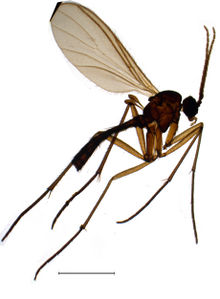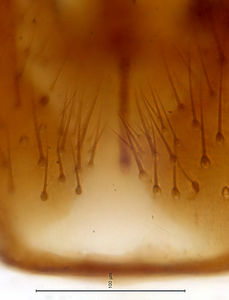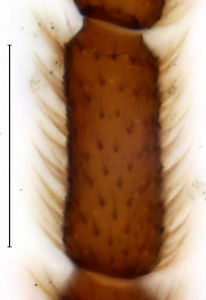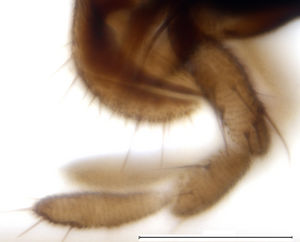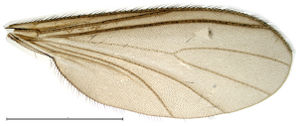Trichosiopsis phoenix
Ordo: Diptera
Familia: Sciaridae
Genus: Trichosiopsis
Name
Trichosiopsis phoenix unpublished
Type material
Holotype: ♂, 04.06.2014, sweep netting, leg. Olsen & Gammelmo, bf-sci-00321 in NHMO
Type locality
Norway, Sogn og Fjordane, Sogndal, Navarsete
Other material studied
Switzerland: 2 ♂,Zurich, Sihlwald, photoeclector, Schiegg, 24.5.-19.06.1996, PKHH 2264/2267; Germany: 8 ♂, Baden-Württemberg, Gaggenau, Katzenbusch, schattiger Auwald, Malaise trap, Doczkal, 14.-23.06.2011 PKHH 8574/8575; 2 ♂, Hesse, Sachsenberg, Felsenkeller, hand collection, Zaenker, 23.06.2001, SDEI 3391; 2 ♂, Rhineland-Palatinate, Idar-Oberstein, Stollen bei der Reithalle, pitfall trap, Weber, 17.08.1996, SDEI 3389/3390; 2 ♂, Saarland, Wallerfangen, Felsdach 2 im Blauwald, pitfall trap, Weber, 30.05.2003, PKHH 5490; 1 ♂, Thuringia, Breitenbach, Vessertal, emergence trap, Bellstedt, 21.06.1987, SDEI 3394; 1 ♂, 27.06.1987, SDEI 3393; 1 ♂, 19.08.1987, SDEI 3392; Italy: 7 ♂, South Tyrol, Stilfzer Joch NP, Suldental bei Schmelz, montaner Fichtenwald, Malaise trap, Lange & Ziegler, 17.-21.05.2005, SDEI 2681-2683; 2 ♂, Suldental bei Schmelz, submontaner Kiefern-Mischwald, Malaise trap, Lange & Ziegler, 21.-31.05.2005, SDEI 2494/2506; 5 ♂, 11.-27.06.2005, SDEI 2756-2760; 2 ♂, Suldental bei Schmelz, montaner Fichtenwald, Malaise trap, Lange & Ziegler, 27.6.-04.07.2005, SDEI 2833/2835; 2 ♂, 13.-25.07.2005, SDEI 3365/3366; 4 ♂, Suldental bei Schmelz, submontaner Kiefern-Mischwald, Malaise trap, Lange & Ziegler, 31.5.-11.06.2006, SDEI 2633/2635; Sweden: 5 ♂, Östergötland, Omberg, Storpissan: old Norway spruce wood, Malaise trap, Swedish Malaise Trap Project, 28.5.-05.07.2005, NHRS 2032-2037; 1 ♂, Småland, Gränna, Lönnemålen, next to old cellar; Norway spruce forest with big harvested ashes, Malaise trap, Swedish Malaise Trap Project, 15.6.-01.07.2005, PKHH 6712; 1 ♂, Torne lappmark, Abisko, Birkenwaldrand, Nordhang, yellow pan trap, Tschirnhaus, 13.-17.07.1991, PWMP 4042.
Description (male)
Head. Eye bridge 4–5 rows of facets. Antenna unicolour. LW-index of 4th flagellomere 1.9–2.3; neck 0.3–0.45 × segment width; transition of basal part to neck pronounced. Colour of neck unicolour. Antennal setae shorter than segment width; of normal strength; sparse; salient. Palpus darkened; of normal length; palpomeres 3. First palpomere elongate; with 5–7 setae; with only sparse sensilla. Second palpomere elongate. Third palpomere as long as first. Thorax. Colour brown, or bicolour. Notum partially brightened. Thoracic setae long and strong; black. Posterior pronotum bare. Mesothoracic sclerites bare. Legs. Colour yellow-brown, or brown. Hind coxa darkened. Setae on front coxa black. Front tibial organ as patch of setae; dark; front tibial organ not bordered. Tibial setae on hind legs normal, shorter than tibial width. Tibial spurs of equal length. Claws untoothed. Wing. Wing slightly darkened; of normal shape. Wing membrane without macrotrichia. Wing venation weak, with faint stM. M-fork of normal shape. R1 ending at or slightly before base of m-fork; posterior veins with macrotrichia; stM mostly with macrotrichia; CuA1 and CuA2 mostly with macrotrichia; bM bare; r-m with few setae; bM:r-M 0.75–0.9; st-Cu:bM 0.05–0.35; R1:R 1.1–1.5; c:w 0.66–0.78. Halter darkened; of normal length. Abdomen. Abdominal setae strong; on tergites black; on sternites black. Hypopygium concolour with abdomen; LW-index 0.6–0.8. Base of gonocoxites with strong setae; gonocoxites broadly separated; inner margin of gonocoxites typically U-shaped; inner membrane of hypopygium scarcely setose; ventral margin of gonocoxite with short setae. Gonostylus elongate; LW-index 2.2–2.5; Inner margin straight; apex equally rounded, or with one obtuse angle. Apical tooth present; without internal structure; of medium strength; LW-Index 4–5.5. Awl-like setae normal; present beneath apical tooth. Megasetae absent. Whiplash-hair absent. Tegmen 0.5–0.7 × longer than broad; rectangular with rounded edges; without special features; central process absent. Length of ejaculatory apodeme/hypopygium 28–38 %; base of ejaculatory apodeme present. Field with aedeagal teeth inconspicuous. Measurements. Body size 2.7–3.5 mm. Hind tibia 1.3–1.5 mm. Wing length 2.4–3.3 mm.
Diagnosis
The new species is placed in the Trichosiopsis rejecta group and can be distinguished from other, similar species by the combination of the following characters: strong setae at the base of the gonocoxites; strong and black setae at the fore coxae; gonostylus thick and with a faint apico-dorsal angle; palpus long and dark; posterior pronotum without setae; length of tibial spines nearly the width of tibia.
Tr. phoenix is most similar to Trichosiopsis cavernarum. Both troglophilic species can be easily distinguished morphologically with certain experience. Tr. phoenix has an apico-dorsally more rounded gonostylus with a longer and more slender apical tooth than Tr. cavernarum. It has longer spines at the tibiae, shorter palpi and usually slightly more darkened legs. The ejaculatory apodeme bears a more strongly sclerotized apical structure, which is only hardly visible in Tr. cavernarum. The most reliable, however insignificant character to distinguish both species seems to be the presence or absence of setae on the postpronotum. These setae are missing in nearly all observed specimens.
DNA Barcoding
The COI sequences are assigned to two different BINs:
- BIN BOLD:ACJ1425 (average distance 1,28%, max. 1.28%, n=11, K2P: 4.98%)
- BIN BOLD:ADG6448 (n=1, K2P: 5.92%)
Ecology
Trichosiopsis phoenix is the second species in the Tr. rejecta complex, besides Tr. cavernarum. which was collected in caves.
Etymology
gr. φοῖνιξ phoinix = reborn bird in Greek mythology. The name makes reference to the arousal of this species from a formerly very confusing species assemblage.
Discussion
Tr. phoenix is not exclusively cave-dwelling, but also quite common outside of caves. The morphological characters such as colour of legs, absence of setae at the postpronotum, length of the gonostylus and the presence of awl-like setae beneath the apical tooth are variable to a certain degree. It is therefore possible, that Tr. phoenix constitutes a complex of cryptic species, which is manifested by one specimen with a differing barcode, which led to the distinction of a different subspecies. More subspecies may already be present among the listed material.
Distribution
Austria, Germany, Italy, Luxembourg, Norway, Sweden, Switzerland.
Subspecies list
Trichosiopsis phoenix infecta - Trichosiopsis phoenix phoenix
Images
|
